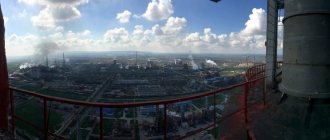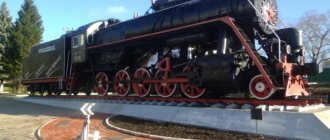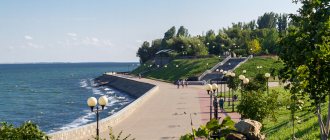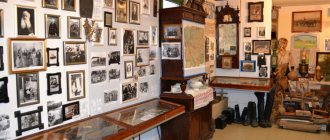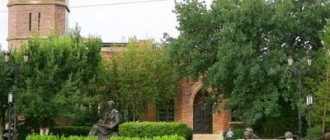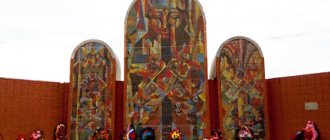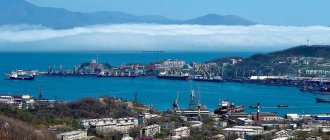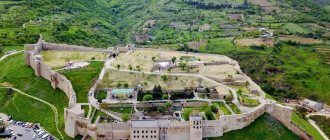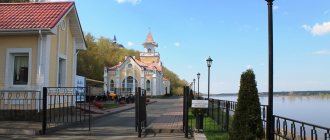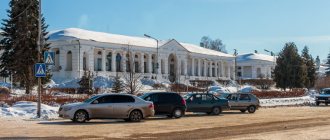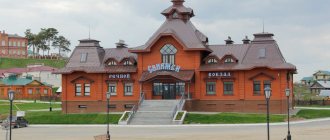Sights of Venev.
Historical reference. The city of Venev, Tula region, is one of the historical cities of Russia. The first mention of this settlement can be found in historical documents from the 1390s. These references concern the battle of Venev between the army of the Pron principality and the Horde with the Grand Duke's Moscow army. Also, mention of old Venev can be found in the letters of the Moscow prince with the Ryazan and Lithuanian principalities. In the sixteenth century, the governor and boyar Sheremetyev I.V. founded the Gorodenensk fortress on Venev. This is where modern Venev is now located. In 1633, Venev was almost completely burned by the Tatars. In 1708 the city became part of the Moscow province. In 1777, Catherine II issued a decree granting Venev city status.
In 1924 it became the regional center of the Tula province. During the Great Patriotic War, the city was under occupation for two weeks. One of the largest manufacturers of diamond tools in Russia, VeAl OJSC, is located in Venev. The population of the city is about 15 thousand people.
St. Nicholas Convent
Located 18 km from the city in a village called Dedilovskie Vysedki . It was founded back in the 15th century, so it is considered one of the oldest in the Tula region. It is famous for the fact that it was here during the reign of Ivan the Terrible that Archbishop Pimen was exiled, who lived in a stone room for a year and then died. Previously, the monastery was male, but at the moment it is female.
There are several caves nearby, so at first the novices lived in them. The main one is the Assumption Church, which was built around the end of the 17th - beginning of the 18th century. It is the only architectural monument of that era preserved in the Tula region.
Heraldic symbols of the city
The history of Russian cities is famous for its special traditions, culture, crafts, events and people. Thanks to proven excursion routes, tourists know a lot about large ancient cultural centers. Meanwhile, the provincial streets of the oldest Russian outbacks also conceal a lot of interesting things.
The coat of arms of the county, which received city status in 1777, depicts the former symbol of successful bargaining, leading to prosperity and satiety for local residents. In the center of the heraldic motif is the so-called golden grain measure, which is a cylindrical vessel for weighing a standard volume of grain for sale. This symbol is recognized as the hallmark of the city and has existed since 1778, reminiscent of the coat of arms of European trade guilds.
By the way, the golden grain measure was otherwise called a quadruple. It had a volume of about 26-odd liters. It was invented for traders who underweight or overweight grain to customers. To avoid disagreements, in 1897 Paul I issued an imperial decree on the approval of grain and drink measures, according to which all traders of bulk goods were obliged to measure grain, cereals and flour in the same measure for everyone.
The Tula region has been known throughout Russia and beyond its borders for a long time for its skill in making Tula gingerbread and lace, samovars and clay toys, accordions and hunting rifles, as well as its blacksmith craft, and the city of Venev is no exception.
Venev grain was famous in all regions and attracted merchants from other regions. The former modest county flourished more and more and turned into a real city with narrow streets and a vast area.
Bell tower of St. Nicholas Church
The bell tower is considered the main attraction of the city, but it is still in a dilapidated state. Previously, it belonged to the St. Nicholas Church, which was founded in 1800. The project was grandiose, and construction work took about half a century. But in the middle of the 20th century, the church was simply blown up. Only the bell tower has survived. What this is connected with is still unknown.
Some believe that they wanted to adapt the building for economic purposes. Others think that people were simply afraid to blow up such a huge building (it could harm nearby houses). But until now the bell tower is the tallest building in the entire Tula region.
Location: Red Square.
Church of the Resurrection of the Word (Olenkovo)[edit]
The stone Church of the Resurrection of the Word was built in 1825 at the expense of the local landowner Sergei Fedorovich Sokovnin. At the end of the 19th century, the parish of the temple included the villages of Sosnovka, Chusovo, Ilyinka and Afanasyevo.
In 1922, the temple was closed, the building was used as a club, and later a winery, vegetable store, and warehouse were opened there.
The bell tower was blown up during the construction of the road.
The dilapidated temple was returned to believers in 1993.
Renovated.
Address:
Tula region, Venevsky district, Olenkovo village, st. Dorozhnaya, 72.
Resurrection Cathedral
The construction of the Resurrection Cathedral was completed in 1752. But after that it was almost rebuilt, so now you can only see the final version, which dates back to the 19th century. For some time, a parochial school operated at the church, then an almshouse was opened. During the Soviet Union, the cathedral was not operational, and the building itself was used as a storage facility. At the moment, restoration work is underway and services are taking place.
Location: Volodarsky street - 15.
War time
By the beginning of the war, the city was the “Venevsky combat area” for formations of infantry and tank troops, commanded by Major General A.D. Tereshkov. The area was occupied by the enemy in November 1941, but on December 9 it was liberated by the army of Lieutenant General P.A. Belov .
For a long time after the occupation, Venev was restored by the efforts of the townspeople and city authorities:
- new residential buildings were built;
- roads stretched;
- street and square spaces were improved;
- children's institutions, schools, hospitals, water supply, telephone communications, and printing houses have been restored;
- the railway, city bakeries, shops, hairdressers, canteens, and hotels began to operate;
- city newspapers began to be published;
- city administration, stadiums, and cinemas appeared.
In the 20th century, Venev was famous for its generous supplies of brown coal, as coal mining was established. New streets, parks, public gardens appeared, and the city grew.
Epiphany Church
This building is located on Red Square. The temple has 2 tiers. The dates for the start and end of construction work have still not been established, but it is known that it was around the 17th century. Previously, the church belonged to the Epiphany Monastery, which is currently destroyed. Restoration work is currently underway in the church, but services are still taking place.
Location: Red Square - 14.
Content
- 1 Resurrection Cathedral (Venev)
- 2 Temple of John the Baptist (Venev)
- 3 Temple of the Epiphany (Venev)
- 4 Temple of the Iveron Icon of the Mother of God (Borshchevoye)
- 5 Temple of the Kazan Icon of the Mother of God (Venev)
- 6 Church of the Icon of the Mother of God “Healer” (Gritsovsky)
- 7 Church of the Resurrection of the Word (Olenkovo)
- 8 Church of the Intercession of the Blessed Virgin Mary (Prudishchi)
- 9 Church of the Intercession of the Blessed Virgin Mary (Tunezh)
- 10 Church of the Nativity of the Blessed Virgin Mary (Havki)
John the Baptist Cemetery Church
This church was built in 1773. By 1795, a bell tower also appeared near it. Then in 1857 they were united. As a result, this architectural composition began to have a finished appearance. By the way, the temple worked even during the war years under the Soviet Union.
Location: Bundurina street - 7A.
In culture and toponymy
The city became the prototype for the fictional city of Verevkin from the series of fantastic stories in the series “City of Verevkin” by Kir Bulychev[70][71]. In honor of the city of Venyov in the southwest of Moscow, in South Butovo, Venyovskaya Street was named[72].
According to one version, Venev is the birthplace of the prototype of the literary character Lieutenant Rzhevsky. Venevskaya landowner Nadezhda Petrovna Rzhevskaya (b. 1848) left behind handwritten memoirs in which she told about the adventures of her uncle Sergei Semenovich and father Pyotr Semenovich Rzhevsky[73].
Venevsky diamond tool factory
The plant was founded in 1975. It includes 2 open joint-stock companies - VeAl and Venfa. At first it was only a separate workshop of the Tomilino Diamond Plant, and then its branch. In 1978 it became an independent institution. He began his work with the production of grinding wheels using domestic synthetic diamonds. More than 200 types of grinding wheels have been created.
By the way, the plant ranked first in Russia in the production of synthetic diamonds. This direction not only fully meets the needs of Russia, but also the products are exported to Bulgaria, Israel, India, Switzerland, and the USA. The plant produces not only a variety of grinding wheels, but also diamond closers, whetstones, and bowls.
Location: Mezhdunarodnaya street - 4.
Population
| ↗5200 | ↗5500 | ↗5900 | ↘5500 | ↗5576 | ↗6261 | ↘5893 | |
| 1979[40] | 1989[41] | 1992[36] | 1996[36] | 1998[36] | 2000[36] | 2001[36] | 2002[42] |
| ↗7124 | ↗13 243 | ↗14 800 | ↗15 400 | ↘15 300 | ↘15 200 | ↗15 300 | ↗16 167 |
| 2003[36] | 2005[36] | 2006[36] | 2007[36] | 2008[36] | 2010[43] | 2011[36] | 2012[44] |
| ↗16 200 | ↘15 900 | ↘15 700 | ↘15 600 | ↘15 500 | ↘15 224 | ↘15 200 | ↘14 866 |
| 2013[45] | 2014[46] | 2015[47] | 2016[48] | 2017[49] | 2018[50] | 2019[51] | 2020[52] |
| ↘14 500 | ↘14 244 | ↘14 198 | ↗14 260 | ↘14 211 | ↘14 191 | ↘14 023 | ↘13 883 |
| 2021[5] | |||||||
| ↘13 691 |
As of January 1, 2022, in terms of population, the city was in 819th place out of 1,116[53]cities of the Russian Federation[54].
Oil
The plant was founded in 2000. It is engaged in the production of dairy food products. The institution not only has modern equipment, but also its own raw material base, which is located 250 km from the city. Every year the plant produces almost 20,000 tons of refined oil under the Russian Seeds brand.
Under this name you can purchase the main types of oils: not only sunflower, but also corn, rapeseed, and also various blends (a striking example is rapeseed-corn oil). In addition, based on the product of its own production, the plant produces mayonnaise (light, olive and Provencal).
Location: Koltsevaya street - 7A.
origin of name
The Veneva River, later renamed Venevka, gave its name to the future settlement of traders. The etymological roots of the name extend from the verb “to twist” and, in the process of historical changes in words, from the nouns “broom” and “wreath”, which have an early interpretation of the meandering of the river.
In the local history museum of Tula - the “Chamber of Antiquities” - Troitsky N.I., its founder, preserved information about the Finno-Ugric people living in that area, among whom the Finnish name for Russia has always existed - Venäjä, sounding like [v, enaj, a], was subsequently distorted in Russian pronunciation.
And according to the study “Venev Antiquities” authored by D. G. Gedeonov, the people of Venev owe the name of the city to the second name for birch in the local area - “Veneva”.
Regional Museum of Local Lore
The institution is located in a building that dates back to the 17th century. Previously, it was considered the city magistrate. The question of opening a museum was first raised in 1956, but only 10 years later permission was given. In 1966 and 1967, searches were carried out for various items for the museum, as well as the premises for this institution. The first exhibition was opened in 1981. Initially, the museum was a branch of the Tula Museum of Local Lore, but in the mid-90s it became a separate institution.
In the museum you can see various folk crafts, archaeological finds, and paintings. Several rooms are themed. For example, there is a room where you can study the history of the Venev land. The second hall dates to the period of the Great Patriotic War, and the third shows the relations between Czechoslovakia and the Soviet Union.
Location: Red Square street - 32.
LiveInternetLiveInternet
The city of Venev is the center of the Venevsky district of the Tula region, located on the Venevka River, 163 km southeast of Moscow and 52 km east of Tula. Founded in 1371, city since 1777. Population 15,220 people (2010), area 9 sq. km.
Venev is a small ancient Russian city , the administrative center of the Venevsky district of the Tula region of Russia. The city of Venev forms the municipal entity of the same name with the status of an urban settlement as the only settlement in its composition. One of 115 historical cities in Russia. On the territory of the city there are about a dozen religious buildings, including the temple complex of the Church of the Epiphany.
Venev train station.
Open-air museum of railway technology. There are two steam locomotives, a BA-11 armored car, a 1930s freight car “teplushka”, a monument to Ivan Alekseevich Likhachev, the founder of the ZIL plant, a native of Venev. In the waiting room of the station there is a bust of Karl von Meck, a major shareholder of the Ryazan-Ural Railway, which passed through the Venevsky district.
On October 30, 2013, a bust of the “railway king” Karl Fedorovich von Meck (1821-1876) . This is a whole sculptural composition consisting, in addition to the bust, of a large bronze panel. The author is sculptor S.G. Polegaev. The panel depicts the von Meck Palace in the village of Khruslovka, Venevsky district, portraits of the three sons of Karl Fedorovich, his wife Nadezhda Filaretovna with the composer Pyotr Ilyich Tchaikovsky. In 1877-1890, she provided financial assistance to the famous composer. Moreover, they never met.
A sculpture of a girl with bread and salt greets everyone arriving at the station.
Ivan Alekseevich Likhachev (1896-1956) was born in Venev, graduated from the City Three-Class School in 1908. For a long time he headed the 1st State Automobile Plant named after I.V. Stalin (ZIS), since 1956 renamed the Likhachev Plant (ZiL). Under the leadership of Likhachev, for the first time in the USSR, they launched a conveyor belt (for the production of trucks), and established mass production of limousines, buses and refrigerators. The monument to Likhachev at the station was unveiled on October 30, 2013, A.N. Burganov. The author depicted Likhachev holding a model of the ZIS-5 car in his palm.
An old heated vehicle, part of the open-air museum's exhibition.
The first written mentions of the Venev settlement date back to the 1390s. Initially, it was located, presumably, 7 kilometers from modern Venev on the Osetra River in the area of the current village of Guryevo. In 1408, in the battle of Venev, the warriors of the Pron principality and the Horde defeated the Moscow grand-ducal army. In 1483 and 1494, old Veneva was still mentioned in the treaty documents of the Moscow Prince with the Ryazan and Lithuanian principalities.
Model of the city of Venev of the 16th century.
In its present location, the settlement appeared as a fortress called “Gorodenesk on Venev” in the middle of the 16th century. The fortress was founded by the boyar and governor I.V. Sheremetv. The city had a good natural fortification location: on one side there was a river with steep banks, on the ground side there was a deep ravine connecting with the river. Soon the fortress came into the possession of Prince I.F. Mstislavsky. In 1571, after a raid by the hordes of the Crimean Khan Devlet-Girey, Tsar Ivan IV took possession from Mstislavsky, accusing him of treason. In 1572 the fortress was renamed Venev. The city suffered especially badly during the Tatar invasion in 1633. It was almost completely burned.
The Nikolaevskaya Bell Tower was once the tallest building in the Tula region. Nicholas Church, designed by the famous architect K.S. Sokolnikov, was erected, among other things, at the expense of Moscow merchants, immigrants from Venev. Grandiose construction began in 1800 and occupied an area unprecedented at that time. Construction of the church lasted 50 years; during construction, the church survived a fire, standing without a spire with a cross for about 22 years. After reconstruction, this cross has stood for more than 150 years and today rises on the high spire of the 75-meter Nikolaevskaya Bell Tower, but many believe that there is a danger of the cross falling at any moment, because it is held at the top only by the reinforcement. After the Great Patriotic War, bullet marks remained on the bell tower and even on the cross, but the structure survived and is still the main dominant decoration of the city of Venev. The church itself was destroyed in the 50s of the 20th century. Why wasn’t the bell tower demolished? According to one version, the tall structure served as a good reference point for pilots. According to another version, they decided not to demolish the bell tower due to the danger of stone fragments collapsing on nearby residential buildings. The third version is miscalculations in the required amount of charge. There is also a version associated with the construction of a water tower, for the needs of which the bell tower was adapted. Unfortunately, today the Nikolaevskaya Bell Tower is in a state of disrepair, and no money is allocated for repairs and restoration.
Church of the Intercession and St. Nicholas Bell Tower, photograph from the late 19th century. The Resurrection Cathedral is part of the architectural ensemble of Red Square in Venev. The cathedral is an architectural monument. It was built in the style of late classicism. The cathedral rises on the banks of the Venevka River and, at the same time as other buildings, creates a single panorama of the building, looking picturesque from the other bank of the river. In ancient times, a fortress, a voivode's house, and other government buildings stood on this site. The Church of the Resurrection was erected on the site of the first Venev church - in honor of Paraskeva Pyatnitsa, mentioned in the Scribe Book of Gorodensk in 1751. This church was burned by the Crimean Tatars in 1633. The construction of the Resurrection Cathedral dates back to 1752. At first the church was made of stone and had five domes. It had two chapels: in honor of the Annunciation of the Most Holy Theotokos and in honor of the Holy Great Martyr Paraskeva (Friday). At the beginning of the 19th century, it was decided to expand the building due to the cramped conditions of the previous church and at the request of Archpriest Ioann Pylaev and parishioners. Funds for the construction of the temple were raised by parishioners and other donors. In 1805, a refectory with chapels in honor of the Annunciation and in honor of the Great Martyr Paraskeva was added to the temple. In 1825 the church was completed. Assistance in the construction of the temple was provided by the nobleman M. Kartukhov. The new building was designed in a classical style. In pre-revolutionary times, the cathedral kept two ancient icons of St. John the Theologian and Paraskeva Pyatnitsa, which were famous for their wonderworking. In 1837, the temple was visited by Alexander Nikolaevich Romanov (heir to the throne and future Emperor Alexander II) with his teacher, the famous poet V.A. Zhukovsky. In the 1930s, the cathedral was closed. It was used for storage space. During the German occupation, captured wounded Red Army soldiers were kept in the building. In the post-war years, the bell tower was destroyed. The building was not used until the 1970s. In 1969, it was registered as a monument; a collection point for glass containers was located inside. In 1988, the temple building was given to the Russian Orthodox Church.
Museum of Local Lore.
The museum is located in the famous Venev Stone Chambers on Red Square. The chambers were erected at the end of the 17th century. In 1804, the city magistrate and city council moved here. During Soviet times, from 1919 to 1972, a library was located in the building of the Stone Chambers. Since 1972, the Venev Museum of Local Lore has been operating here on a permanent basis, which began its activity in 1981. The following halls are available for inspection: archaeological, pre-revolutionary life, noble, military and exhibition. During the tour, you can personally walk through a secret passage discovered during renovations in 1980.
The stone church of the Epiphany (late 17th – early 18th centuries) was built in the Baroque style.
The architecture of the temple combines the forms of the late 17th century with the more luxurious decoration of the new century. The corners of the first tier are decorated with bunches of columns; the corners of the octagon are emphasized by narrow flagella; the window openings are decorated with rich platbands.
In the merchant chambers of the Evdokimovs, from the beginning of the 19th century, a hotel was located in 1970.
Evdokimov family, mid-19th century
City Library.
Modern trade in ancient merchant shops.
Zavyalov tavern. And now there is a bar, restaurant and sauna.
The building of the Kuznetskoye drinking establishment was built at the beginning of the 19th century. It got its name from the large number of forges located nearby outside the city. Nearby were the main gates of the city - the Moscow Outpost. Several big roads converged on it: Tula, Moskovskaya, Bogoroditskaya. The main street of the city, Bolshaya Moskovskaya, began from the Moscow outpost; today it bears the name of the great Russian writer Leo Tolstoy.
Nowadays, the building has acquired a modern look.
Part of the old buildings of the city.
House of the Zmiev nobles, 19th century
The house of the merchant Tulin Nikolai Nikolaevich, now it is the House of Culture.
House No. 16 on Lev Tolstoy Street was built at the beginning of the 19th century. At the beginning of the 20th century, the house was purchased by merchant Nikolai Nikolaevich Tulin and placed a huge manufacturing store on the entire ground floor.
The Rodionovs' bakery and lamb shop was the largest enterprise in Venevsky district at the beginning of the 20th century. 37 people worked here. The largest workshop was engaged in baking the famous Venev bagels.
The theological school was founded in 1815 in the neighboring town of Epifani. In 1838 he was transferred to Venev. The surviving complex of buildings was built at the end of the 19th century. About 120 people studied at the religious school. It was a territorial educational center for Kashira, Venevsky and Epifansky districts.
In 1881, a specialized modern building was built for
the City School .
It was the main city educational institution. There were two separate entrances for girls and boys; education was separate until 1917; they did not intersect inside. Students and teachers of the city school, late 19th century.
Since there was not enough space for all the students in the city school, in 1913 a specialized building was built on Red Square the women’s department of the city school
Initially, the Church of the Intercession was called St. Nicholas Church. The brick building in the provincial baroque style was built in 1737 at the expense of the Gladushev merchants. In 1862, after the construction of the new majestic St. Nicholas Church, of which only the bell tower remains today, the old St. Nicholas Church was re-lit as the Intercession Church.
One of the largest urban buildings in the city before 1917. For more than 50 years, this building was occupied by the County Zemstvo Government. This house was originally built by the Kostolyndin merchants at the beginning of the 19th century.
Photo of the late 19th century
The building, which today is called the Cinema , was built at the beginning of the 20th century by the district zemstvo. After the revolution there was a printing house here. In the 1950s, a spacious cinema hall was added. Film screenings are still shown here, using modern equipment.
, the Moscow brewing partnership Trekhgornoye operated successfully in Venev .
Here there was an office of the partnership, a warehouse for products and a beer hall. During the First World War, after the announcement of Prohibition, the pub closed, and the premises were occupied by an infirmary with 45 beds. The house of the Zavyalov merchants was built in the 2nd quarter of the 19th century. In addition to the grocery store on the ground floor, they were engaged in grain trading, buying it from surrounding peasants.
Zavyalov family
Two-story house No. 30 on Red Square was built at the end of the 18th century. The adjacent one-story outbuilding was marked on city plans as early as the 1770s. It was this house that was rented by the last leader of the district nobility, Prince Alexei Nikolaevich Shakhovskoy, at the beginning of the 20th century. In 1911, he published the book “What Everyone in Russia Needs to Know,” which gained great fame. The book was intended for children, telling about the history of Russia and its modern structure. The prince considered the main goal of his work to be the education of patriotism.
Prince Alexey Nikolaevich Shakhovskoy
House No. 9 on Lev Tolstoy Street was built in the 1st quarter of the 19th century.
In the 2nd half of the 19th century, here on the ground floor there was the most famous restaurant in the city, Prokofy Dmitrievich Zaitsev, and on the second there was a hotel.
The bright building on the right is Zaitsev's rooms . The city in the photograph of the late 19th century looks completely different than it does now.
City administration building
The Church of John the Baptist was built in 1773 through the efforts of residents of the city of Venev. At first, the church did not have a bell tower, which was built separately in 1795, a few meters east of the temple itself. More than half a century later, in 1857, through the efforts of church warden I.V. Brezhnev, the church was connected to the bell tower, as a result of which a warm refectory church was formed. Thus, in 1857 the church acquired the appearance in which it remains to this day.
The church is the only one in the area that has not been closed since its construction to the present day, including the Soviet period and the Patriotic War. At the beginning of the 21st century, the dilapidated gilded cladding of the domes and crosses on the temple and bell tower were replaced. One of the crosses is kept in the Venev Museum of Local Lore. The stone fence with forged iron entrance gates and wicket has been preserved. The cemetery contains tombstones of famous people of past centuries. On some Venev tombstones there are engraved titles such as “state councilor” or “merchant of the first guild”.
Monument to the Tsar Liberator Emperor Alexander II in Venev, 1913
Unfortunately, the monument to the Tsar Liberator Emperor Alexander II, erected in 1911, has not survived to this day. Its restoration would be useful from the point of view of preserving historical memory and rehabilitating the victims of the Bolshevik regime.
Residents of Venev at the beginning of the twentieth century. The Mukholov and Strizhenov family , 1912 The man in the background is wearing an electrician’s safety belt.
Old buildings of the city, mainly private sector.
Department of Internal Affairs of the city
Obelisk at the grave of the chairman of the Venevsky district Cheka, Ivan Matveevich Rogozhin, and the military commissar of the Urusovsky volost, Yegor Pimenovich Bizyukov, who died during the counter-revolutionary rebellion during the establishment of Soviet power in the Venevsky district in 1918.
Raev Vasily Vasilyevich, 1930 A native of the Venev Pushkarskaya Sloboda, a participant in the Second World War.
Germans in Venev, winter 1941
The Alley of Heroes on Ilyich Square in Venev was opened in 2005 on the 60th anniversary of the Victory of the Soviet people in the Great Patriotic War. 31 Heroes of the Soviet Union and 5 full holders of the Order of Glory, who the Venev with their exploits are immortalized on it .
The pedestal with the 52-K anti-aircraft artillery cannon was built in 1966 to commemorate the 25th anniversary of the defense of the city of Tula and the liberation of the Venevsky region from the Nazi invaders, as well as in memory of the soldiers of the Venevsky combat sector, including the soldiers of the 732nd anti-aircraft artillery shelf.
Stela - Venyov - city of military glory.
Monument to F.F. Petrov on Bundurina street.
Fedor Fedorovich Petrov (1902-1978) - designer of artillery systems, Hero of Socialist Labor, Laureate of the Lenin and four State Prizes of the USSR, Doctor of Technical Sciences, Lieutenant General. Born in the village of Doktorovo, Venevsky district. The sculptor is Alexander Vasilyevich Chuikov, the son of Marshal Vasily Ivanovich Chuikov. The monument was erected on May 6, 1985.
Worship cross on the site of the altar of the Church of St. Nicholas.
Monument to Ulyanov Lenin, obligatory for all cities and towns of the USSR.
Views of the city of Venev and its inhabitants.
Traditional drying of clothes.
Boys of the city of Venev.
Young Venev artist in the open air.
Venevsky resident... now in all cities of Russia there are such residents...
Venevskaya city tree.
* * * * * * * *
Old photographs of Venev.
L. Tolstoy street view of the Nikolskaya bell tower in winter. The large building on the right is the house of the merchant Tulin. (1903)
Crowd of people on Red Square in Venev. Late XIX - early XX centuries. The photo was taken from the second floor of Protopopova's house. Apparently, the photo shows an icon of the Vladimir Mother of God from the village of Smolenskoye-Gretsovo, Bogoroditsky district. She was especially revered in the cities of Venev and Bogoroditsk. The icon was decorated with a silver chasuble of 84 standard, weighing 30 pounds. The year of minting was marked on the chasuble - 1773. According to the inscription on the icon, it was painted in 1545 on the promise of Philip Timofeevich Pashkov. (Parishes and churches of the Tula Diocese) It is known that the icon was brought to Venev in 1905. In 1891, the mayor of Markov applied for permission to bring the icon as well.
Moskovskaya Street (L. Tolstoy), beginning of the 20th century (1901-1902). The sign says “STORE N.N.” TULINA."
Dvoryanskaya (Proletarskaya) Street, Theological School, late 19th century
Zemskaya hospital on Ryazanskaya street. 1912
Four-class city school on Red Square, 1910
Theological school. The photo was taken during the First World War.
Church of the Entry of the Blessed Virgin Mary into the Temple. Not preserved.
Ryazanskaya (Svobodnaya) street, early 20th century.
Source1 Source 2
Source "Twelve Keys"
The source “Twelve Keys” is located in the village of Sviridovo near the city of Venev. This unique place has been consecrated. It has been fully equipped for tourists. In 1991, archaeological excavations took place in this place. 14 burials were discovered that date back to the 12th-14th centuries. A bathhouse was built near the source, and there is also a chapel, which was consecrated in honor of all the saints. Her cross was created by stonecutter V. Talkov, who is the brother of the famous singer.
Location: Sviridovo village (2 km from the city).
Church of the Intercession of the Blessed Virgin Mary (Prudischi)[edit]
In 1765, the wooden Intercession Church was built, which operated until 1890. Instead, in 1886-1899, at the expense of parishioners and the landowner of the village of Ozerniki, Ivan Mikhailovich Sambulov, a stone church was built with three altars: the Intercession of the Mother of God, the Great Martyr Dmitry of Thessaloniki and the Archangel Michael in the refectory.
In the 1930s, the temple was closed and the building housed a granary. Around 1968 there was a fire that destroyed almost all the frescoes.
The temple was returned to believers and is being restored.
The village of Prudishchi is the birthplace of St. Barnabas of Gethsemane (in the world - Vasily Ilyich Merkulov).
Address:
Tula region, Venevsky district, Prudishchi village
Guryevsky quarries
These quarries are represented by three separate systems of passages, which are located near the Sturgeon River. Since there is a village nearby called Byakovo, the quarries are also called Byakovsky. By the way, they are considered the longest in the European part of the Russian Federation. The length is more than 100 km. The history of these quarries dates back to the 15th century. Here convicts mined limestone.
Notes
Comments
- According to other sources, the name “Gorodenesk on Venev” was shortened to the short “Veneva” by the end of the 17th century. At the end of the 18th century, the masculine name “Venev” came into use, which is still used today[3].
Sources
- Official website of the municipality (unspecified)
. Access date: September 17, 2022. - ↑ 1 2 3
Venev
(unspecified)
.
Great Russian Encyclopedia
. Date accessed: May 8, 2022. - ↑ 1 2 3 Makhel D.
Origin of the name of the city of Veneva
(undefined)
.
Venevsky district
. - Tula region. Total land area of the municipality
- ↑ 12
The permanent population of the Russian Federation by municipalities as of January 1, 2022 (Russian). Retrieved April 27, 2022. Archived May 2, 2022. - Law of the Tula Region of March 11, 2005 No. 549-ZTO “On the renaming of the municipal entity “Venevsky District of the Tula Region”, establishing boundaries, conferring status and determining the administrative centers of municipal entities in the territory of the Venevsky District of the Tula Region”
- “On approval of a new list of historical populated places of the RSFSR” (unspecified)
. Date accessed: August 18, 2022. - Malitsky, 1895, p. 215.
- Pospelov, 2002, p. 93.
- ↑ 12
Troitsky, 1895. - Gedeonov, 1854.
- Map of the Tula Region (undefined)
.
Map of Russia
. Date accessed: August 18, 2022. - Encyclopedic Lexicon, 1837, Venev, p. 368.
- Malitsky, 1895, p. 216.
- ↑ 12345
Atlasov, 1959. - Tarkhov S. A.
Changes in the administrative-territorial division of Russia over the past 300 years
(unspecified)
. Access date: July 8, 2022. - Drawings of the coats of arms of cities, 1843, p. 103.
- ↑ 12
Reign of the Empress, 1830, p. 598. - A brief history of the city of Veneva (undefined)
.
Venevsky district
. - ATD of the Union Republics, 1980, p. 231.
- Bocharov A.P.
Tereshkov Alexey Dmitrievich (Russian). Website "Heroes of the Country". - ↑ 12
Liberation of the cities, 1985. - Moshchansky, 2010, p. 224-225.
- Liberation of cities. THE USSR. A-B (undefined)
. Soldat.ru. Date accessed: August 18, 2022. - Venevskaya Central District Hospital (unspecified)
.
Medicine of the Russian Federation
. Date accessed: August 18, 2022. - Borozdinsky, Uklein, 1974.
- Organizations of the city of Venev (undefined)
.
Venev.
City portal . Date accessed: August 18, 2022. - Venevsky Creamery (unspecified)
. Date accessed: August 18, 2022. - Venevsky sour cream and curd factory (unspecified)
. Date accessed: August 18, 2022. - Plant for the production of bakery products (unspecified)
. Date accessed: August 18, 2022. - SCA (undefined)
. Date accessed: August 18, 2022. - Coat of arms of the city of Venev (undefined)
.
Geraldika.ru
. - Coat of arms of the city of Venev and Venevsky district (undefined)
.
Venev Online
(August 18, 2018). - Tourism brands will be developed for small towns in the Tula region, Mislo News
(August 18, 2018). - Venev logo chosen, Red Banner
(August 18, 2018). - ↑ 1 2 3 4 5 6 7 8 9 10 11 12 13 14 15 16
People's Encyclopedia “My City”.
Venev (undefined)
. Access date: June 25, 2014. Archived June 25, 2014. - All-Union Population Census of 1939. The size of the urban population of the USSR by urban settlements and intra-city areas (unspecified)
. Retrieved November 30, 2013. Archived November 30, 2013. - All-Union Population Census of 1959. The size of the urban population of the RSFSR, its territorial units, urban settlements and urban areas by gender (Russian). Demoscope Weekly. Access date: September 25, 2013. Archived April 28, 2013.
- All-Union Population Census of 1970 The size of the urban population of the RSFSR, its territorial units, urban settlements and urban areas by gender. (Russian). Demoscope Weekly. Access date: September 25, 2013. Archived April 28, 2013.
- All-Union Population Census of 1979 The size of the urban population of the RSFSR, its territorial units, urban settlements and urban areas by gender. (Russian). Demoscope Weekly. Access date: September 25, 2013. Archived April 28, 2013.
- All-Union population census of 1989. Urban population (undefined)
. Archived from the original on August 22, 2011. - All-Russian population census 2002. Volume. 1, table 4. Population of Russia, federal districts, constituent entities of the Russian Federation, districts, urban settlements, rural settlements - regional centers and rural settlements with a population of 3 thousand or more (unspecified)
. Archived from the original on February 3, 2012. - All-Russian population census 2010. Number and distribution of the population of the Tula region (unspecified)
. Access date: May 18, 2014. Archived May 18, 2014. - Population of the Russian Federation by municipalities. Table 35. Estimated resident population as of January 1, 2012 (unspecified)
. Retrieved May 31, 2014. Archived May 31, 2014. - Population of the Russian Federation by municipalities as of January 1, 2013. - M.: Federal State Statistics Service Rosstat, 2013. - 528 p. (Table 33. Population of urban districts, municipal districts, urban and rural settlements, urban settlements, rural settlements) (undefined)
. Retrieved November 16, 2013. Archived November 16, 2013. - Table 33. Population of the Russian Federation by municipalities as of January 1, 2014 (unspecified)
. Access date: August 2, 2014. Archived August 2, 2014. - Population of the Russian Federation by municipalities as of January 1, 2015 (unspecified)
. Access date: August 6, 2015. Archived August 6, 2015. - Population of the Russian Federation by municipalities as of January 1, 2016 (Russian) (October 5, 2018). Retrieved May 15, 2022. Archived May 8, 2022.
- Population of the Russian Federation by municipalities as of January 1, 2022 (Russian) (July 31, 2017). Retrieved July 31, 2022. Archived July 31, 2022.
- Population of the Russian Federation by municipalities as of January 1, 2022 (Russian). Retrieved July 25, 2018. Archived July 26, 2022.
- Population of the Russian Federation by municipalities as of January 1, 2022 (Russian). Retrieved July 31, 2019. Archived May 2, 2022.
- Population of the Russian Federation by municipalities as of January 1, 2022 (Russian). Date accessed: October 17, 2022. Archived October 17, 2022.
- taking into account the cities of Crimea
- https://rosstat.gov.ru/storage/mediabank/bul_Chislen_nasel_MO-01-01-2021.rar Population of the Russian Federation by municipalities as of January 1, 2022 (1.85 Mb, 07/30/2021)
- Mashnina Elena.
Tourists must see the area's rich
heritage
. newspaper "Red Banner"
(01/18/2019). Date accessed: September 7, 2022. - Prutskaya Alina.
From legend to tradition.
The X festival “12 Keys” (undefined)
.
AiF
(05/07/2016). Access date: September 24, 2022. - Red Square (undefined)
.
Venevsky district
. Date accessed: August 18, 2022. - Venev: which building is the tallest (undefined)
. Date accessed: August 18, 2022. - Mound of Immortality (undefined)
.
Venevsky Museum of Local Lore
. Date accessed: August 18, 2022. - Venevsky Museum of Local Lore (unspecified)
.
Venevsky district
. Date accessed: August 18, 2022. - myauu
.
Exposition at the railway station Venev station (unspecified)
. Date accessed: August 18, 2022. - Tsapaev, 2014, p. 524-526.
- Evdokimenko Georgy Stepanovich (unspecified)
.
History of domestic special services
. Date accessed: August 18, 2022. - Historical figures of Venevsky district (unspecified)
. Date accessed: August 18, 2022. - Isaeva I. S.
Pages of the history of domestic gardening
(unspecified)
. Fruit Garden. Date accessed: August 18, 2022. - Boris Nikolaevich Abramov (unspecified)
(inaccessible link). Retrieved March 29, 2022. Archived April 14, 2022. - Nikolai Andreevich Lunev (unspecified)
. Date accessed: August 18, 2022. - Boris Alekseevich Ignatov (undefined)
. Date accessed: August 18, 2022. - Venev's notes. Personalities (unspecified)
(inaccessible link). Date accessed: August 18, 2022. Archived July 6, 2022. - Kazantsev spoke.
I change with the times, but I want to write the way I want
(undefined)
.
Russian Science Fiction
. - Venev picturesque (undefined)
.
Venevsky district
. - Venevskaya street (undefined)
.
Our Butovo
(August 18, 2018). - How Tula Venev can attract tourists (Russian). Russian newspaper
. Access date: June 20, 2022.

